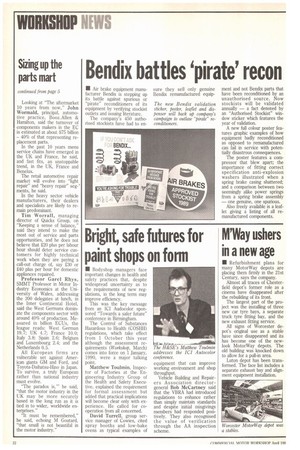Sizing up parts mart
Page 105

Page 122

If you've noticed an error in this article please click here to report it so we can fix it.
• In the automotive components market, "Small is not beautiful," the Financial Times Motor Conference, held with the Single European Market of 1992 in mind, was told.
Noel Goutard, chairman and chief executive of Parisbased Valeo, the second largest equipment company in .Europe, was asked: "What market share will a components manufacturer need?"
"I think 10% is nowhere," he replied. "with 10% you are dead; 20% is the minimum."
Mergers? Consolidation? "We are buying a new company every one to two months.
"Consolidation is the biggest eating the smaller," he added. And at present there are around 1,500 suppliers and 10,000 sub-suppliers in Europe.
What does the future hold for British components firms? What is the future for British
ownership? Dr John White, group managing director of the BBA Group, said that the UK components industry is compelled to seek its destiny at least on a European scale, and probably on a world scale.
"The question is, therefore," he said, "of capital availability to serve and compete within a global industry rather than capital availability to serve a much diminished home-based build."
Attrition, redistribution and easy access for the Japanese components industry are but three alternative scenarios for the future, he said. But he believes Britain has the nucleus of a strong industry left.
Dr White, with a paper entitled "The future of the UK component's industry," said towards the end that he had left implicit the response to two important questions. "Is there a future for a components manufacturing business based in Britain and owned by a nonBritish capitalist?
"The answer," he said, "is unequivocally yes!"
Speaking on the "Impact of GEM restructuring on Europe's component makers," K E Ludvigsen, managing director of Ludvigsen Associates, independent management consultancy based in Bond Street, London, said the UK will hold the European presidency in the last half of 1992 when final, possibly heroic, decisions have to be taken.
After that, the rapid expansion of paperless communication within the EC will become feasible, he said.
There will be a disincentive for the EC to agree on communications standards that will be compatible with those used by the US and/or Japan, he said.
Looking at "The aftermarket 10 years from now," John Worrnald, principal, automotive practice, Booz.Allen & Hamilton, said the turnover of components makers in the EC is estimated at about $75 billion – 40% of that representing replacement parts.
In the past 10 years menu service chains have emerged in the UK and France, he said, and fast fits, an unstoppable trend, in the UK, France and Benelux.
The retail automotive repair market will evolve into "light repair" and "heavy repair" seg-' ments, he said.
In the heavy sector vehicle manufacturers, their dealers and specialists are likely to remain predominant.
Tim Worrall, managing director of Quicks Group, on "Keeping a sense of balance," said they intend to make the most out of service and parts opportunities, and he does not believe that 220 plus per labour hour should deter service customers for highly technical work when they are paying a call-out charge of, say 230 or 240 plus per hour for domestic appliances repaired.
Professor Garel Rhys, SMMT Professor in Motor Industry Economics at the University of Wales, addressing the 200 delegates at lunch, in the Inter Continental Hotel, said the West Germans dominate the components sector with around 40% of production. Measured in billion ECUs, the league reads: West German 19.7; UK 4.7; France 10.0; Italy 3.8; Spain 2.6; Belgium and Luxembourg 2.4; and the Netherlands 0.5.
All European firms are vulnerable set against American giants GM and Ford, and Toyota-Daihatsu-Hino in Japan. To survive, a truly European rather than national industry must evolve.
"The paradox is," he said, "that the motor industry in the UK may be more securely based in the long run as it is tied in to wider, worldwide enterprises."
"It must be remembered," he said, echoing M Goutard, "that small is not beautiful in the motor industry."








































































































































